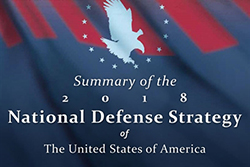From the Analysis Desk: Avascent Analytics 2018 National Defense Strategy Overview

Defense Secretary James N. Mattis announced the new National Defense Strategy in a speech at the Johns Hopkins School of Advanced International Studies. Image courtesy of the US Department of Defense. On January 19, the US Department of Defense released an unclassified summary of the new National Defense Strategy (NDS). This document characterizes the United States as emerging from a “period of strategic apathy” into one of long-term strategic competition with revisionist powers China and Russia. America’s focus on combating terrorism has degraded its ability to respond to these challenges. Thus, the National Defense Strategy plans to invest in the readiness and lethality of the military, securing and reinforcing alliances, and insuring that Department of Defense priorities are geared to these peer competitors. While the explicit priority on “revisionist powers” is new in the 2018 NDS, many of the strategy’s recommendations for investment focus, force posture, and other areas continue trends that the DoD has been pursuing for some time.
The NDS outlined several investment priorities to focus on combatting high-end, high-technology threats. Unsurprisingly, the modernization of aging US nuclear forces topped the list as the Services invest billions into the Colombia-class nuclear ballistic missile submarine, Ground-Based Strategic Deterrent (GBSD), and the Long-Range Standoff Weapon (LRSO) to counter significant nuclear investments by Russia and North Korea. This will drive spending at the National Nuclear Security Administration under the Department of Energy and would also be coupled with increased spending on missile defense.
Meanwhile, the Department of Defense will also focus on fighting in the digital battlespace, to compensate for US C4ISR investments, dependency upon non-resilient space-based capabilities, and limited contingency planning in case these core capabilities are compromised. These efforts would be supported by investments in autonomy, advanced computing, robotics, and other advanced technologies to expand the lethality of the force. While the NDS does not state specific billpayers, these investments could come at the detriment of programs which are focused on operations in low-threat or permissive environments, such as the Air Force’s OA-X light attack fighter.
Facing multiple high-end threats in disparate regions of the globe, the Department of Defense is looking to use “Dynamic Force Employment” as its new force structure strategy. According to the NDS, Dynamic Force Employment is centered around increasing America’s ability to rapidly deploy forces at a strategic level to counter threats as they evolve. This “proactive and scalable employment of the Joint Force” is likely to hinge upon significant expansion of prepositioned equipment and warstocks near likely major conflict zones in order to enable the rapid surging of combat forces ahead of potential conflict, recapitalization of strategic mobility assets, more dispersed basing plan, and an overhauled and resilient supply chain. Meanwhile, previous investments into A2/AD have gained a specific focus as the DoD has placed a particular interest in the penetration of “adversary air and missile defense networks to destroy mobile power-projection platforms,” a reference to capabilities like the North Korean missile program and Russian Iskandar missile launchers.
While much of the partnership section retains a focus on historical goals (expand Asian alliances, reinforce NATO, create a Middle East coalition, etc.), this section bears the most significant marks of the Trump Presidency. First is the calling of allies and partners to increase their military investments in order to “amass the greatest possible strength” to insure continued security for all, a direct impact of the President’s aggressive calls for increased military spending by allies. Second, while not stated in the document, was an explicit backing of the beleaguered State Department as an important national security asset by Secretary of Defense Mattis during the NDS briefing. This comes as the State Department is facing the threat of significant funding reduction while the Secretary of State warded off plans for his ouster late last year.
Finally, it is important to remember that the National Defense Strategy is a planning document, and an often vague one at that. Previous defense reviews never overcame institutional inertia. While this newest defense review seems driven by a changing operational environment, its implementation will be challenged by a Congress entrapped in a budget quagmire, an unpredictable President, and an institution that is heavily invested in existing programs. Thus, the National Defense Strategy should be viewed as tool the Department of Defense will use to shape the FY19 and FY20 budgets amid these competing priorities.



